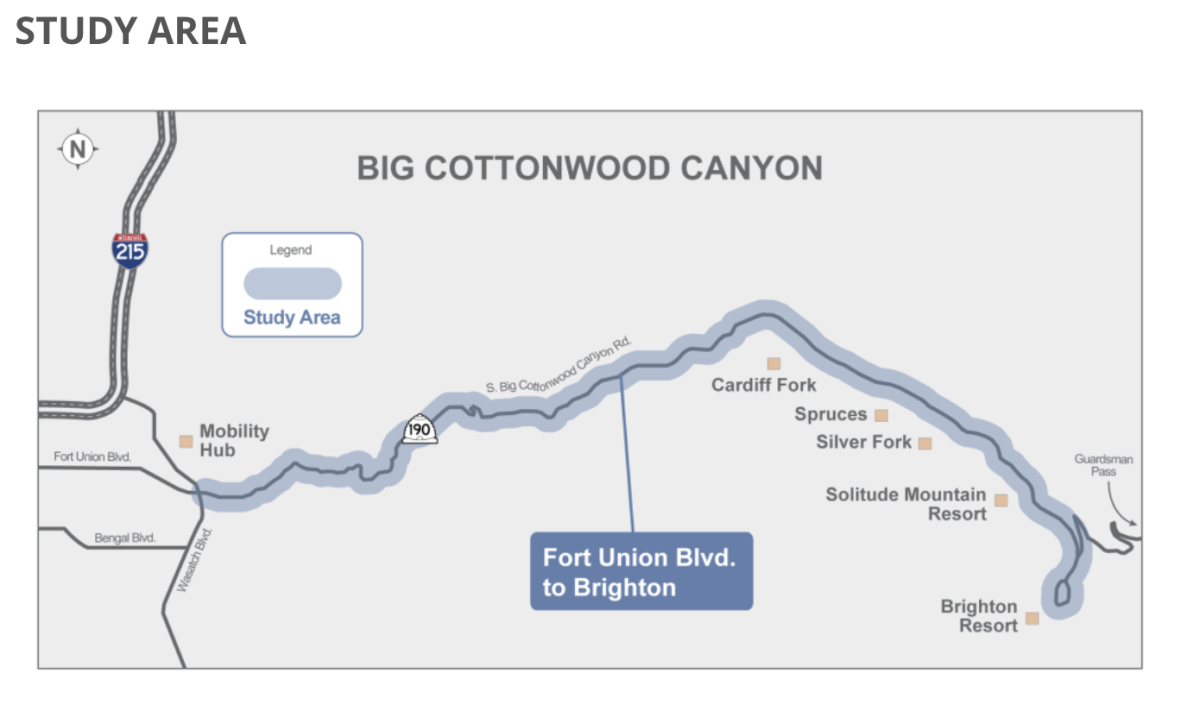Save Our Canyons is closely following the upcoming Utah Department of Transportation (UDOT) environmental review for proposed transportation solutions in Big Cottonwood Canyon (BCC) and is participating in a working group to inform the process. While we don’t know exactly which solutions to traffic UDOT will propose throughout this process, or whether this review will require an Environmental Impact Statement (EIS), Environmental Assessment (EA), or Categorical Exclusion (CE), Save Our Canyons has advocated that UDOT provide multiple opportunities for public comment throughout the review process, giving advocates opportunities to affect which solutions are prioritized throughout the review. As this is the scoping phase, or first public phase of the environmental review, this is our community’s best opportunity to affect what UDOT prioritizes throughout the entirety of the environmental review process.
We must participate in every step of the process, and Save Our Canyons is working to minimize impacts to the environment, watershed, wildlife habitat, adjoining streams and wetlands from any new infrastructure proposed throughout the review.
As pressure grows to address winter congestion, this is a critical moment to ensure that any new transit measures reflect our shared commitment to conservation, equitable access, and the integrity of our public lands. UDOT’s review will explore options such as expanding bus stops and implementing a toll system just beneath Solitude, to primarily impact resort users during winter months. However, it’s essential that these developments prioritize minimal environmental impact and equitable access for all users, both financially and for dispersed recreation, like backcountry skiing, not just those visiting the ski resorts.
Prioritizing Minimal Impact on Big Cottonwood Canyon’s Ecosystem
Any proposed infrastructure for Big Cottonwood Canyon (BCC) must respect the beauty and wildness of BCC. New bus stops, tolling infrastructure, or other developments should be carefully sited to avoid impacts on sensitive ecosystems, including wetlands, streams, and critical wildlife habitats. Development of open spaces or public lands should be strictly avoided for these transit updates, and where impacts are unavoidable, UDOT must commit to restorative measures, such as reseeding disturbed areas or creating additional protected wild spaces as an offset.
Save Our Canyons believes any transportation solution should make conserving the environment a top priority. This includes not just physical landscapes, but also the habitat that many species depend on, the clean water fed by Big Cottonwood’s streams, and the serenity of natural landscapes that visitors come to experience.
Equitable Access for All Canyon Users
More people visit BCC than LCC annually, but winter in Big Cottonwood Canyon isn’t just for those hitting the slopes at the ski resorts. Thousands of backcountry skiers, snowshoers, winter hikers, photographers, and more visit the canyon each year to experience its untouched winter beauty. Implementing a toll without offering robust public transit options would disproportionately impact these non-resort users who rely on Big Cottonwood Canyon for recreation and respite. Save Our Canyons advocates that any tolling should be paired with expanded public transit options—such as frequent, reliable bus service—to ensure that no group of canyon visitors is financially barred from accessing these public lands.
For any tolling to be equitable, it must consider the diverse users who rely on the canyon, especially those who might not be able to shoulder additional costs. Transportation solutions should prioritize interconnected systems that provide access for everyone, regardless of their destination in the canyon. To do this, additional bus routes should connect to existing transit nodes across the Salt Lake Valley.
Connected Transportation Planning Across Canyons
Big Cottonwood Canyon doesn’t exist in isolation, and neither do the transportation challenges faced by the Wasatch Mountains. As UDOT considers solutions, it’s crucial that impacts on neighboring canyons and our communities —like Little Cottonwood and Millcreek— are taken into account. Changes in one canyon inevitably affect the others, especially during peak winter months when traffic, parking, and congestion are widespread concerns across our communities.
A tolling system in Big Cottonwood, for example, could shift visitor traffic to Little Cottonwood or Millcreek Canyon, creating new burdens on those areas. A connected transportation plan should address transit demands across the Wasatch Front, creating synergy between the various transportation solutions, whether tolling, bussing, or other systems. This kind of integrated planning will make it easier for visitors to use public transit effectively, reduce vehicular congestion across multiple canyons, and protect sensitive areas from being overrun by displaced traffic.
Preserving Canyon Access and Resources Through Thoughtful Solutions
As we look ahead to implement these proposed transportation changes, we must also address the potential impacts on trailheads, parking facilities, and popular canyon destinations. Increased access through new transit options could result in additional pressure on trailheads and natural areas, so Save Our Canyons is calling for proactive planning to accommodate increased use without sacrificing the tranquility of our wild spaces. Trailhead expansions, parking needs, and increased visitation to sensitive areas must be carefully managed to avoid eroding the very experience that draws so many to Big Cottonwood Canyon. In conjunction with additional transit options, it’s critical that planning accounts for increased visitation to maintain trailheads and facilities additional bus routes will service.
Join Us in Advocating for Big Cottonwood Canyon’s Future
The public’s voice is critical to shaping a transportation solution that serves the community live along the Wasatch without compromising Big Cottonwood Canyon’s natural beauty.
Join us at the upcoming public scoping meetings on November 13 and 14, where we’ll be advocating for a plan that reflects our shared values: minimal environmental impact, equitable access, and sustainable long-term planning that respects the canyon’s unique ecosystem.
While ski resort parking reservations at Solitude, Brighton and Alta have made a big impact on congestion in the Cottonwood Canyons, our community is critical to communicating to UDOT, elected officials and project planners that any transportation changes to Big Cottonwood Canyon can’t come at the expense of the quality of the environment, the beauty of BCC’s ridgelines and slopes or the clean water, rivers and streams that make the experience on public lands within Big Cottonwood Canyon world-class.
Stay tuned for more details on upcoming meetings and copies of Save Our Canyons scoping comments on the review. Thank you for standing with Save Our Canyons as we continue to work toward thoughtful, sustainable transportation solutions for our cherished Wasatch Mountains. Together, we can help ensure that Big Cottonwood Canyon remains a place for all to enjoy, now and in the years to come.


